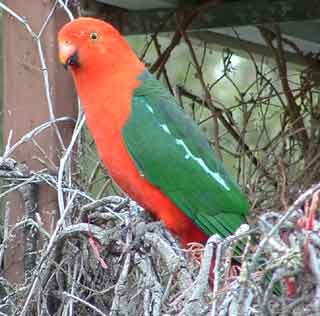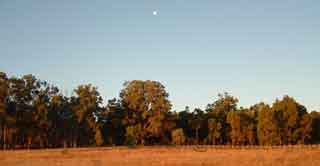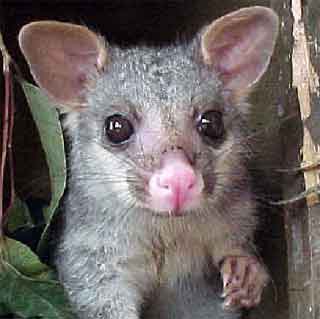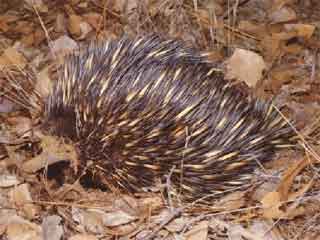
The flora and fauna of Budgee Budgee has changed over the years. Some native species have disappeared as development has taken place. One of the most common food sources for the local indigenous population was the common pigweed the minute black seeds of which were collected and ground into flour.
Likewise the kurrajong was to the natives, a kind of ‘yam’. The edible juicy roots and the large seeds in their pods were appreciated. Early settlers sometimes used the kurrajong for interior furnishings. The bulrush found in local swamps formed an important food when pulled up and roasted on hot coals. The bulrush also had the added advantage of having a useful fibre for nets and dilly-bags.

Mistletoe has become a menace in the district as it has in other settled areas as has the introduced St John’s Wort and Patterson’s Curse. Paddy melons seem to have disappeared in recent years.
In the Budgee Budgee area, particularly on what is now known as Budgee Tops eucalyptus of various species are dominant trees as well as white and yellow box. In 1821 Lieut. William Lawson wrote of the delightful country around Mudgee noting particularly “a chain of fine large meadows” covered principally with apple trees. This apple tree or apple gum as locals call it is Angophora intermedia. It is a most useful shade tree and as a drought reserve fodder. These trees are mainly on the uncleared slopes and when they are in bloom bees collect the nectar for honey.

Cypress pines, the ironbarks and box trees have supplied timber for building and fencing. Casuarinas or river she oaks grow profusely along the banks of Pipeclay Creek. Where school buildings once stood the odd imported peppercorn tree still survives.
The local native wattle, a scrubby bush that barely grows more than one metre high, has survived in small pockets. This acacia seems to bloom irregularly and when it does the flowers are a pale yellow verging on white. Introduced wattle species such as the Cootamundra and Sydney wattles have acclimatised well and produce masses of golden blooms. The Cootamundra flowers in early spring and the Sydney later in the season. The bees love them and the result is a flow of golden honey in the hives.

River red gums can still be seen in Lawson Park in Mudgee and some have been planted on small acre farms in Budgee Budgee.
In the late 1870s the Budgee Budgee locality had not been developed as it has been in the past twenty years when some of the larger holdings were divided into 25 acre lots and sold to escapees from the city known as “hobby farmers” or “blockies” although the latter term has faded into obscurity and is rarely heard today.
There are many vineyards and olive groves where once there were open paddocks with flocks of grazing sheep. The merino and its fine fleece was king and it still is in other parts of the region. However, cattle still can be seen as well as the odd alpaca.

What is extinct in the Budgee Budgee locality is the native plant known as ‘five corners’. Henry Lawson wrote that he and the other children of his schooldays would often search the paddocks for this edible berry that had a pink bell like flower before the berries arrived.
In 1992 ‘five corners’ were still growing on a property near Cassilis and attempts to transplant to Budgee Budgee young plants or grow from seed failed. What was thought to be a small colony of ‘five corners’ was identified as ‘geebungs’ from the same family but definitely not ‘five corners’.
The search for ‘five corners’ in Budgee Budgee continues.
Many species of introduced trees, shrubs and flowering plants are now part of the landscape.
On farmlets where the local Mudgee red grass grows prolifically bird and animal life survives. Budgee Tops is another haven.
Kangaroos abound and seem to move according to the season. In the spring the herd on the farms around Budgee Tops graze contentedly undisturbed. In the winter family groups stay close to houses. Each group appears to consist of a buck kangaroo, a female with young at the heel and another in the pouch.
At one time the common rabbit and hare prevailed and were cursed by farmers but these have been eradicated by science. Those that crop up from time to time make good eating for the sly foxes that appear on the scene when searching for food.
On occasions the peculiar cry of the native quail can be heard in the bush.

Echidnas have become accustomed to human intruders and are known to pay periodic visits from their hiding places in search of ants, small insects and water. To watch their antics, especially if they are a family group, is quite amazing.
The greatest survivor of them all is the bushy tailed possum. They take up residence wherever it suits them. Often this is in the roof of a house or in a farm shed. They are night prowlers. They are heard but rarely seen. Locals have learnt to live with them. A nightly supper of apple, pear, and banana or water melon keeps them happy and stops them from destroying gardens.
In the spring the song of the courting grey butcher bird and willy wag tail as they build their nests is music often unheard in the city. Likewise the fragile blue wrens, with their ever wagging tails, build nests, often in plants on a patio, and rear two or three young.
Put out some small seeds near a bird bath and native finches flock to the table.

The kookaburras, magpies and crows keep their distance but are always searching for edibles.
Summer time sees the arrival of various parrots. On the flat ground can be seen the eastern rosellas and pink and grey galahs.
Occasionally flocks of the screeching and destructive Major Mitchell White parrots arrive. They can decimate a vineyard of its new shoots in a short space of time.
The most welcome of all are the green and red King Parrots. It would not take much effort to tame them even though they are always nervously aware of the human presence. Once again, like the finches, they love seed and sometimes will eat from a hand held container.
It depends where you live in Budgee Budgee to see the flora and fauna described above. Patience is a great virtue when it comes to looking for some of them. To grow the flora is difficult so the local flora and the fauna are best observed in the wild.

You must be logged in to post a comment.